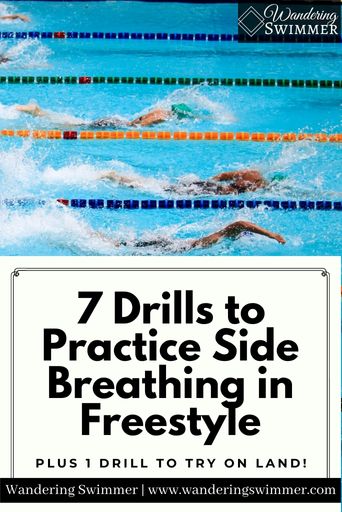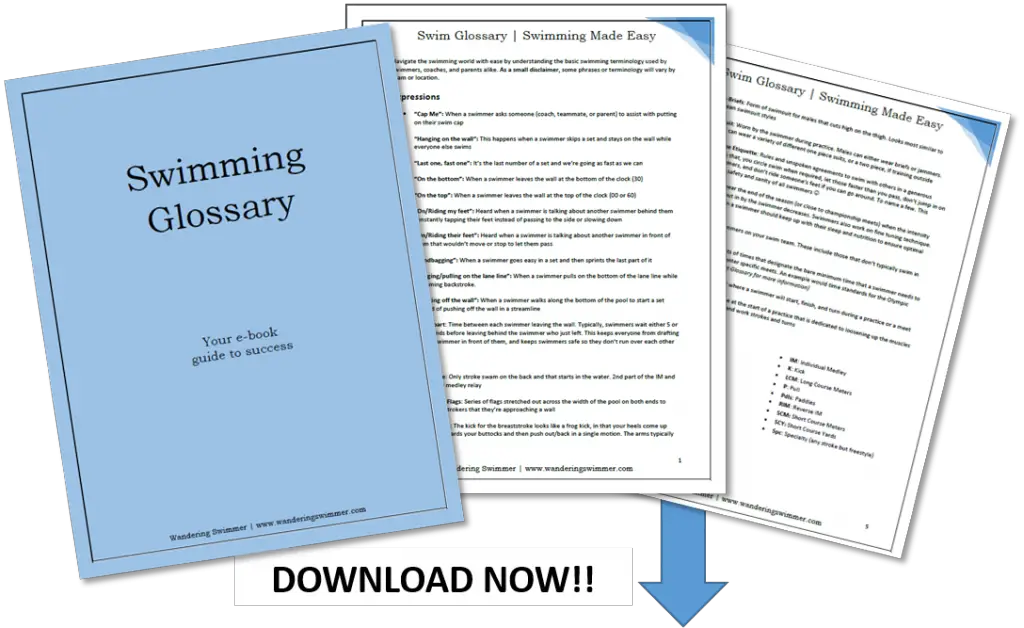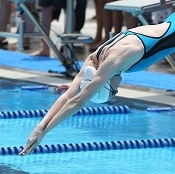Side breathing in freestyle (or the front crawl, as it’s also known) is the technique of choice for competitive swimmers. But it can be intimidating to those new to swimming.
And while you might be more comfortable with lifting your head to breathe, side breathing in freestyle is much easier and less effort. We promise 🙂 Breathing to the side will also improve your freestyle stroke and make it much smoother.
Related article: How to Side Breathe When Swimming Freestyle
Here are 7 drills to help you learn how to side breathe when swimming freestyle. Plus one bonus exercise to practice on land before you tackle side breathing in the water!
Disclosure: This post may contain affiliate links, meaning we earn a small commission at no cost to you if you purchase something through one of our links. As an Amazon Associate, we earn from qualifying purchases. Please check out our disclosure page for more information.

Practice Breathing on Land
When learning to breathe when swimming freestyle, we suggest that you practice the motions on land first. Moving your arms through the air and without any water surrounding you is easier.
The best place to practice this is in the privacy of your home. If only so that people don’t give you strange looks!
You can also do this just before getting into the water and work it into your pre-workout stretching 🙂
- Start with leaning over so your torso is horizontal to the ground. This will mimic your body also being horizontal in the water.
- Begin your freestyle stroke
- Every 3-4 strokes rotate your hips to the side so they’re slightly perpendicular to one side
- If breathing to your right, your left hand should be stretched out in front of you and your left hip should be angled down. Your right hand will be out of the ‘water’ and your right hip will be rotated up. Reverse this if breathing to your left
- Bring your arms back around to finish the stroke while rotating your hips and head back to face the ground
- Repeat!
Practicing this drill helps you get the feel of rotating your body and head to the side to get your air. You should be able to feel your hips help guide your shoulders and torso through the rotations.
Related article: 7 Common Freestyle Stroke Mistakes
Tips and Suggestions
Speed
For some, it may be easier to keep the stroke at your normal speed while practicing freestyle breathing on land. Others may find that it helps to slow down the stroke and exaggerate the rotation and motion of the arms.
If you find that you need to slow the stroke down, that’s okay! Keep at a slower pace until you feel comfortable with the rotation feeling. Once you feel comfortable, try to speed up the motion until you’re at the usual speed you would swim in the water.
Breath Control
This may sound silly but it’s easier to practice holding your breath and learning when/how to breathe without the water surrounding you.
Another tip we recommend is that you focus on your breathing.
Related article: How to Flutter Kick in Freestyle
You can either wait to incorporate this into the drill until after you’ve mastered the rotation motion. Or, you can try it from the start. Either will work 🙂
To work on your breathing, you’ll want to hold your breath whenever your face is pointing down. This would be the time that your face is in the water.
- As you start the rotation to turn your body to the side, exhale out through your nose.
- In the water, this would cause bubbles which in turn, prevent water from getting up your nose!
- Once your mouth crosses the ‘water line’ you can take your breath
- Close your mouth as you start to rotate your body and face back into the ‘water’, while at the same time, exhaling slightly through your nose. Again, this will help keep water from getting up your nose
- Hold your breath again as you face the floor and take a few more strokes
- Repeat!
It will take time to get the breathing pattern correct and to a point that it feels natural. Keep practicing it until you start to feel comfortable with it!
7 Drills to Practice Side Breathing in Freestyle
There’s no shortage of drills to practice once you’re in the water that can help you learn to breathe when swimming freestyle. Some are easier than others and based on your ability, you can jump to the drills that meet your needs.
If you’re just starting out learning to breathe to the side in freestyle, we recommend that you start with the first drill and build up. It takes time to learn and feel comfortable with side breathing.
Most of these drills can be done without any gear or equipment. At most, you’ll need a kickboard for two of the drills. You can also use a set of fins to make some of the drills easier as they can keep your hips higher in the water.
Related articles:
1. Standing and Breathing Drill
To get used to the motion of rotating and breathing to the side in freestyle while in the water, try this drill! It’s simple in that you can just stand still, put your face in the water (facing the bottom of the pool), and rotate your head to the side to breathe.
That’s it!
It seems silly and you may feel ridiculous, but this is great to help you get the feel of the motion in the water. Additionally, it’s one of the best ways to learn how and when to breathe.
Related article: Why is Swimming So Hard?
Doing this while standing still can help you time when to inhale and exhale through your mouth and nose. Along with how much to inhale and exhale, and learning to blow bubbles.
Do this several times until you feel comfortable before moving on to the next drill.
2. Hand on the Wall Breathing to the Side
Once you have the feeling down of turning your head to the side to breathe, you can start to add in a kick. Do this by following the below steps:
- Hold onto the wall or gutter in your pool with one hand and your arm fully extended (left arm for this example) Keep your other arm down by your side (right arm)
- Lightly kick and look down at the bottom of the pool
- After a few seconds, rotate to the side not holding onto the wall. For this example, this would be your right side
- Exhale through your nose and mouth as your head turns to the side, preventing water from getting in your nose
- As best you can, only let one eye/goggle come out of the water as you rotate. You will need to contort your lips up and to the side. If you can’t do this, turn more of your head so more of your mouth is above the water to get your air.
- Take a quick breath
- Rotate your head and shoulder back down in the water, exhaling slightly as you do so.
- Repeat
Stay with the same side when practicing this breathing drill until you feel like you have mastered the motion. Switch to the other side when you’re ready.
You may find that breathing to one side is easier for you than breathing to the other side. This is actually normal! While you’ll be more balanced breathing to both sides, it’s okay to stick with just one side.
More Content for You: 7 Best Waterproof MP3 Players for Swimming
When doing this drill, stay relaxed and rotate so that the side of your face and shoulder come out of the water. Remember that as your shoulder rotates up, your opposite hip should be angled down.
3. Kickboard Breathing Drill
Time to start moving! Grab your kickboard and put it in front of you so that the long side of the board faces you. Doing this keeps your hands shoulder width and will help prevent a tight stroke.
To get started, push off from the wall and start kicking. Take about 6-8 kicks before turning your head to the side to take your breath. After you get your breath, rotate your head back down to the bottom of the pool.
Take your next set of kicks and turn to breathe again.
More Content for You: How to Count Laps in Swimming (With Reference Tables)
Keep your hands on the board as you continue to kick and take your breaths. The point of this drill is to keep working the motion of breathing to the side in freestyle and your breathing patterns.
Even with your arms extended and holding onto the board, your shoulders and hips should still rotate some. If you’re having trouble turning your head enough, make sure you keep kicking while breathing. Don’t let your kick stop or your hips will sink.
Some swimmers find it easier to do this drill with fins. Fins will give you a bit more oomph on your kick and can keep your hips higher in the water.
4. Stroke and Kickboard Breathing Drill
Progressing from the previous drill, you’ll now add a stroke into the mix.
As with the earlier drill, start with the kickboard out in front of you and begin kicking. When you’re ready to take your first breath, however, you’ll also take a stroke at the same time.
Do this by:
- Keeping one hand on the kickboard (left for this example) and the other hand releasing its grip on the kickboard (right)
- Bring your right hand down and start your stroke
- As your hand passes through the water, you should also be rotating your hips and shoulders to breathe at the same time
- If you get anxious at this stage, keep kicking with your left arm still extended and on the kickboard. Keep your right arm back and your body/head angled to the side to get your breath
- Bring your right back over the water and start to rotate your body/head back into the water so you’re facing the bottom of the pool
- Grab the kickboard and start again
Remember that throughout this drill, you should keep a constant kick to keep your hips up. If needed, add fins so you can make the most of the drill.
You’ll also want to work your breathing pattern to avoid water in your nose and to start feeling a natural rhythm that works for you.
5. Breathing without Kickboard
Removing the kickboard will add a new level of difficulty to this drill. Because of this, we suggest that you only start this drill once you feel comfortable with side breathing. We also recommend that you wear some fins to give you some extra help.
This drill is the same as the previous drill, only you won’t be using a kickboard. As the name probably implies 😉
Instead, you’ll be kicking your arms extended in front of you and taking a stroke every few kicks. You’ll need to engage your abdominal muscles for this to keep balanced in the water.
You may find that it’s harder to get your air as the kickboard isn’t there to provide buoyancy for you. If this is the case, don’t panic. Kick and rotate a bit more until you can get the air you need.
6. One Arm Stroke and Breathing
One of my favorite freestyle drills! This is great for not just learning to side breathe in freestyle but it’s also an excellent stroke drill to work rotation and technique.
When doing this drill, you’ll want to keep one arm down at your side while you’re swimming. Your other arm will be doing a freestyle stroke. You’ll need to use your core muscles to keep yourself balanced and rotating in the water. And you may find it easier to use fins to help with the rotation.
More Content for You:
The point of this drill is to breathe to the side that’s not taking the freestyle stroke. This will help force your hips and torso to breathe more on your side instead of lifting your head to breathe.
You’ll need a constant kick to help with the rotation but try your best not to rotate so much that you’re on your back! 🙂
You can do this drill for the length of the pool using one arm and then switch arms coming back. Or, you can take 6-8 strokes with one or before switching to the other arm.
While you can breathe to the side that’s stroking, you may not be able to get the full rotation. Or you may swallow some more water. Try breathing to both sides though to see which is easier for you!
7. Arms at Your Sides
You’ll want a pair of fins for this drill to help you rotate. While you don’t need them, we have found that it’s much easier with them on.
For this drill, you’ll push off the wall on your stomach with your body facing the bottom of the pool. Put your arms at your sides and start kicking.
Once you’re ready to breathe, engage your core muscles and rotate your hips, torso, and head to the side. Get your air and roll back to your stomach. Repeat down the pool.
More Content for You: 8 Best Swim Bags for Swimmers (And Water Enthusiasts)
You shouldn’t be over-rotating so that you roll completely to the side. Instead, this drill will mimic the rotation needed to take your breath when swimming freestyle.
For some, this can be a challenging drill while others may find it more enjoyable. If you struggle a bit to get your shoulders and hips to rotate, that’s okay! Try instead turning just your head to get your breath and gradually work in the body rotation.
Freestyle Side Breathing Tips
Remember that learning to side-breathe when swimming freestyle doesn’t happen overnight. It does take time and it takes constant practice. Don’t let yourself get discouraged if you feel that you’re not making progress.
We also suggest that you take your time with these drills and take enough rest at the end of the pool each time. This will allow you to catch your breath before starting the drill again.
If you rush through the drill and your rest, you’re not helping yourself. Rushing drills doesn’t build the foundation of your technique. And skipping rest will make it harder when your body is starved for oxygen.
Lastly, you will get water up your nose in the first several attempts. Just as you’ll likely inhale some water. Keep going though. It will become more natural as you practice. You can also use a nose plug if it gives you more confidence.
In Closing
Learning how to side breathe when swimming freestyle will improve your swimming and make it much easier.
It may take some time to get through the drills and to a place where you feel confident with side breathing, but you can do it! Remember to stay patient, practice often, and don’t give up.
As always, happy swimming!
Chevron
Bonus Content
How Many Laps is a Good Swim Workout?: How many laps make for a good swim workout isn’t an easy answer. It depends on a few variables. Keep reading to find out how to have a good swim workout.
8 Best Swim Parkas for Swimmers: Whether you’re at a swim meet, lap swimming, or playing water polo, staying warm is crucial to finding success in the pool. Here’s our breakdown of the 8 best swim parkas for swimmers and other water enthusiasts.

Want to Improve at the Pool?
Join swimmers and swim parents to receive my free newsletter and receive a free Swimming Glossary e-book as a thanks!
Every month you’ll receive tips and coaching to help you find success at the pool.
About

Chevron is a current competitive swimmer with almost 20 years of experience in the pool. And although she fell into the sport by accident in her high school years, she still trains daily and competes throughout the year. She’s committed to providing guidance to all levels of swimmers and believes that everyone should know how to swim.